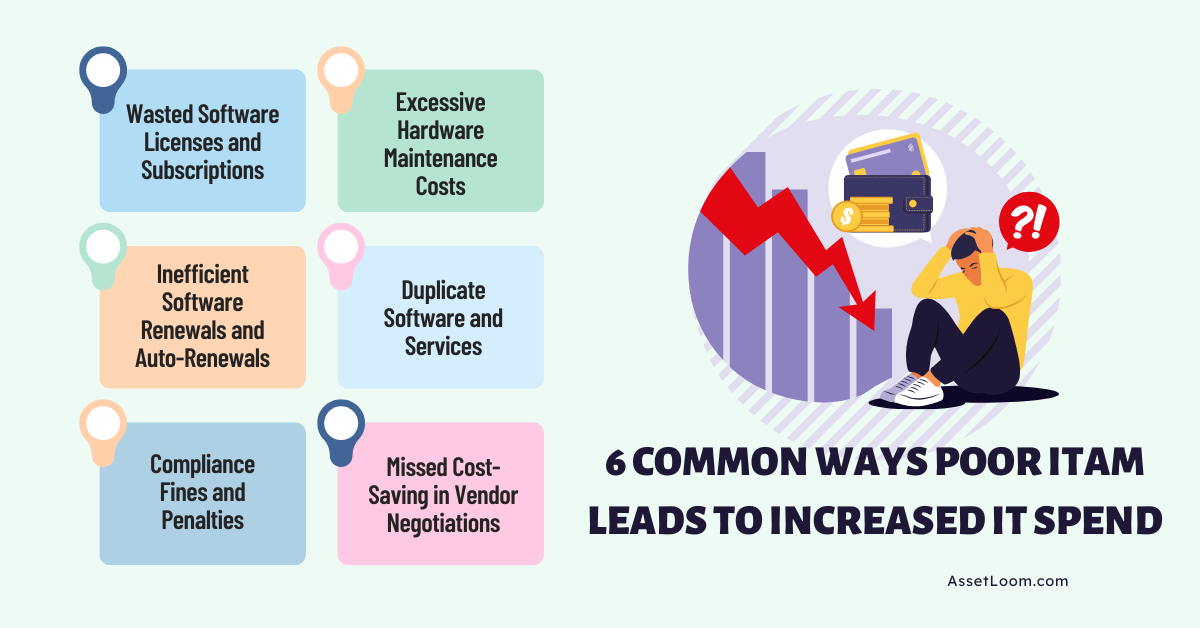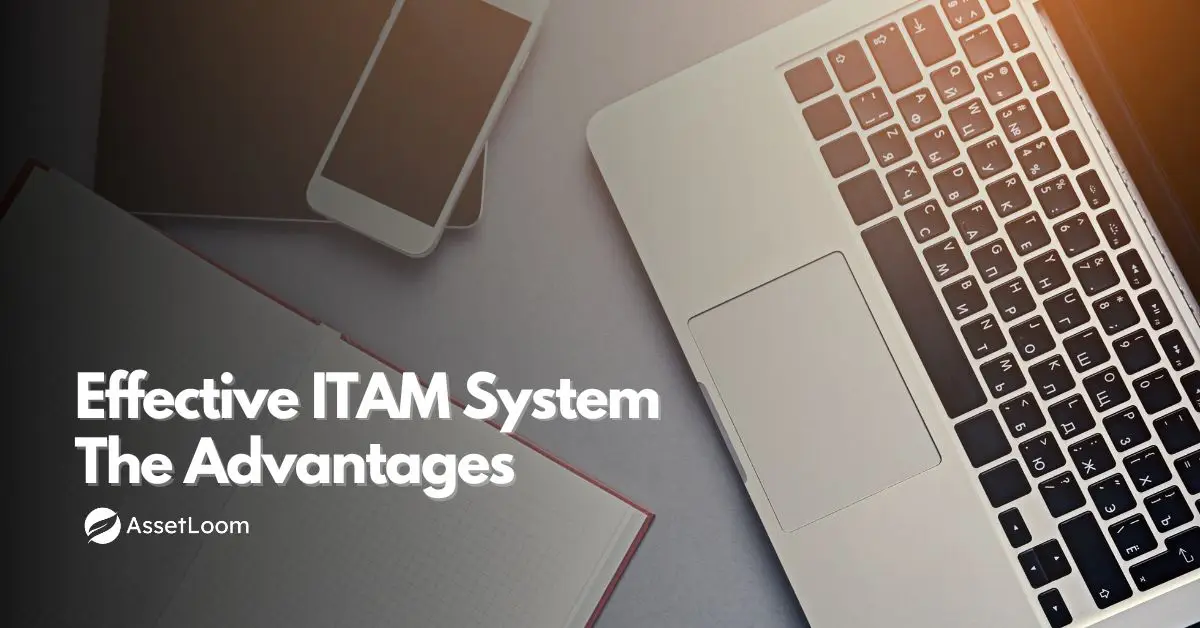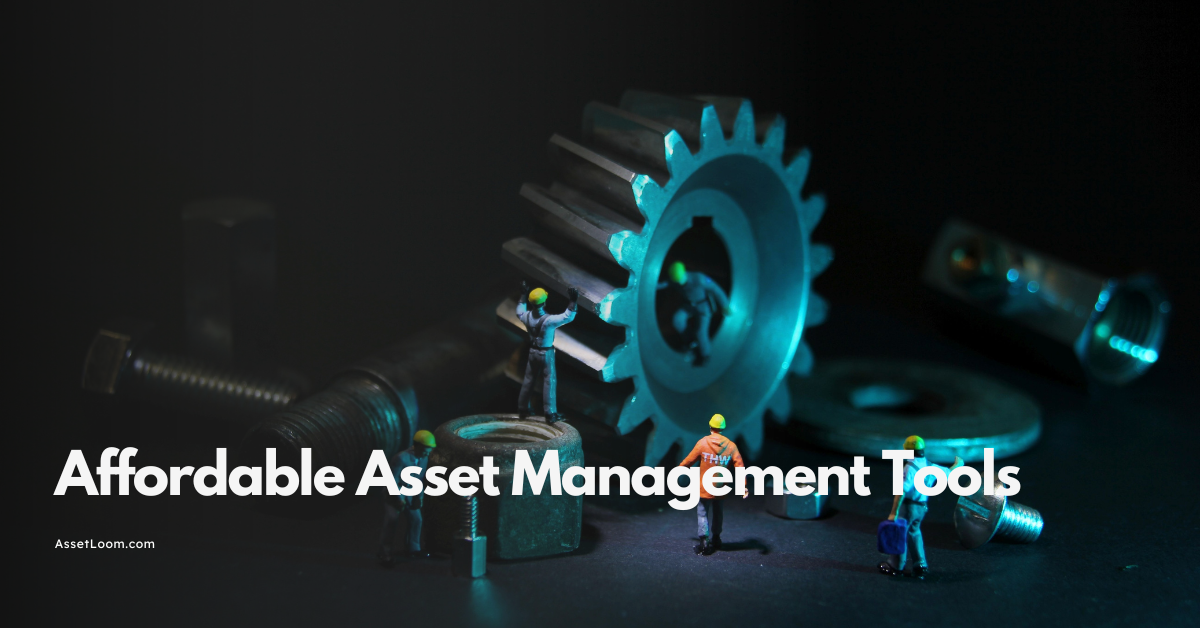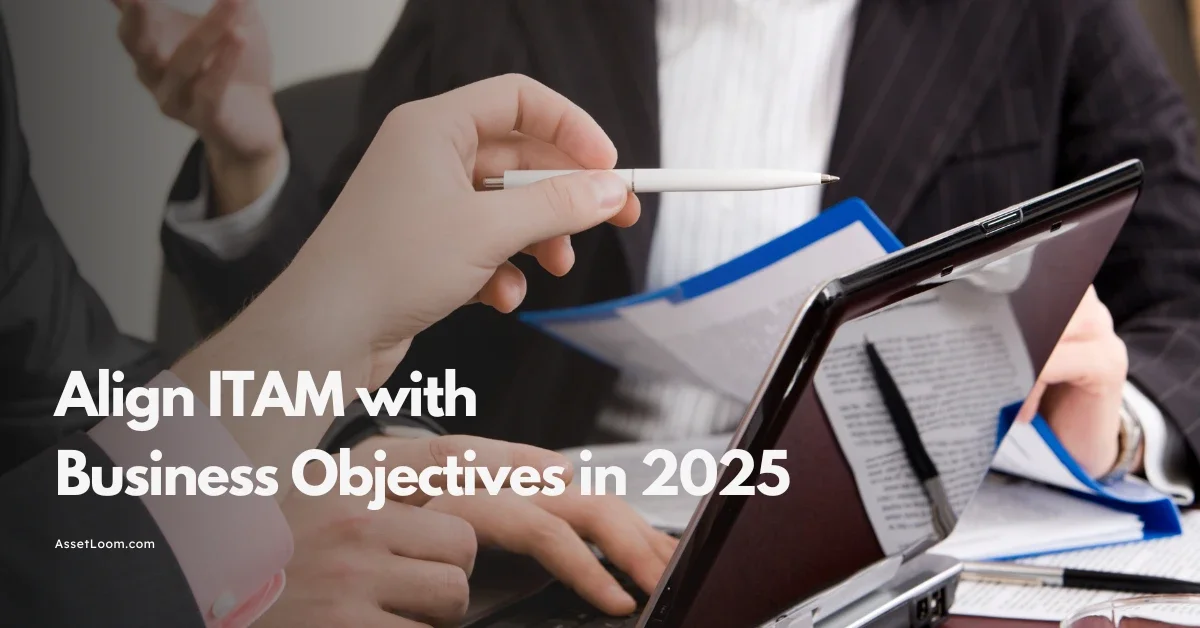How Poor IT asset management (ITAM) Increases Your IT Spend
Poor IT asset management (ITAM) drives up IT costs, hidden costs can quickly accumulate. These costs often go unnoticed, but over time, they lead to significant and avoidable expenses.
Poor IT asset management (ITAM) could be quietly inflating your IT budget. While your organization focuses on operational priorities, you might be overlooking hidden costs in the form of unused software, outdated hardware, and missed vendor contract opportunities. These costs might seem small at first, but they can quickly add up to a significant portion of your IT spend.
The good news is that these hidden costs can be controlled with a more strategic approach to ITAM. In this blog, we’ll explore the common ways poor ITAM leads to unnecessary IT expenses and provide practical tips on how you can identify and eliminate these hidden costs. By doing so, you can improve resource efficiency, align your IT spending with actual needs, and make better-informed decisions that save both time and money.
Let’s dive in and look at how you can regain control over your IT assets and reduce costs in ways that will benefit your bottom line.
What is ITAM?
IT Asset Management (ITAM) is a structured approach to managing the lifecycle of your IT assets, which includes hardware, software, and related services. From the moment assets are purchased to when they are retired, ITAM provides a framework for tracking and optimizing their use. It involves managing everything from procurement, deployment, and maintenance, all the way through to disposal or recycling.
ITAM is more than just an inventory system. It ensures that all IT assets are properly recorded, tracked, and utilized. The goal is to extract maximum value from your IT investments by aligning assets with organizational needs, maintaining them properly, and ensuring that they are used efficiently throughout their lifecycle.
=> What is IT Asset Management (ITAM)? The Basics Every Business Should Know
How Poor ITAM Increases Your IT Spend
When IT assets are not managed properly, hidden costs can quickly accumulate. These costs often go unnoticed, but over time, they lead to significant and avoidable expenses. Let’s take a closer look at 6 common ways poor ITAM leads to increased IT spend:

1. Wasted Software Licenses and Subscriptions
A major pitfall of poor ITAM is the failure to track software usage properly. Many companies purchase more software licenses than they actually need, or they don’t keep track of which licenses are being used and which are sitting idle. This is especially common with subscription-based software, where companies may renew contracts for licenses that aren’t being used.
As a result, overbuying software and subscriptions that aren't being used efficiently adds unnecessary costs to your IT budget. With better tracking and management, these costs can be reduced.
2. Excessive Hardware Maintenance Costs
When hardware gets old, it often requires more frequent repairs and takes up more energy. Keeping outdated equipment running instead of upgrading it or replacing it with newer models can cause maintenance costs to skyrocket. While it may feel cost-effective to hold onto old equipment, the truth is that those repair bills and energy costs add up over time, and the performance often declines.
By not managing the lifecycle of their hardware properly, businesses are spending more on repairs and energy than if they had replaced the server with a newer, more efficient one. Proactively replacing outdated hardware before it becomes a costly burden is essential to avoid unnecessary spending.
Example: A company continues to use an old server that’s past its prime. The server needs frequent repairs, causes slowdowns, and consumes more electricity, leading to higher electricity bills and maintenance fees.
3. Inefficient Software Renewals and Auto-Renewals
Many software subscriptions or service contracts automatically renew, often without checking whether the organization still needs them. If you don’t actively manage your renewals, you may end up paying for services that no longer align with your needs, or that are underutilized.
Therefore, these unwanted renewals can drain your budget, especially when they’re not accounted for. With proper ITAM practices, you can track renewal dates and either cancel unnecessary subscriptions or renegotiate terms to reduce costs. This way, you’re only paying for the services you actually need.
4. Duplicate Software and Services
In large organizations, different departments might independently purchase the same or similar software without consulting each other. This can result in paying for duplicate tools that offer overlapping functionality.
this redundancy means that money is being spent on two services that could be consolidated into one. An effective ITAM system can track software across the organization, identify overlaps, and help consolidate software tools, ultimately saving money.
Example: One department purchases a project management software tool, while another team buys a similar product. Both tools essentially do the same thing, but now the company is paying for two subscriptions.
5. Compliance Fines and Penalties
Non-compliance with licensing agreements or regulatory requirements can result in heavy fines. If IT assets are not properly tracked and managed, it’s easy to accidentally exceed the number of licenses purchased or violate compliance regulations.
In addition, these fines can be costly, especially if they’re for large-scale non-compliance. In addition to the financial penalty, it may damage your organization’s reputation with vendors. By keeping an accurate record of software usage and ensuring compliance with licensing terms, you can avoid these unexpected costs.
6. Missed Cost-Saving Opportunities in Vendor Negotiations
Without a clear view of all IT assets and contracts, organizations miss out on opportunities to renegotiate contracts or leverage better pricing. Lack of centralized asset management means you might not realize that you’re paying too much for a service or that a vendor could offer better terms based on your actual usage.
Without understanding your total IT spend and usage across the organization, you might miss out on volume discounts or favorable contract terms. By consolidating contracts and reviewing them regularly, you can take advantage of better deals and reduce vendor-related costs.
Identifying and Eliminating Hidden IT Costs Through ITAM Optimization
Optimizing IT asset management (ITAM) is key to identifying hidden costs that often go unnoticed until they accumulate over time. A well-structured ITAM strategy helps you manage your assets efficiently, streamline operations, and save money. Here’s how to approach ITAM optimization to reduce unnecessary IT spend:
1. Centralize IT Asset Management
Centralizing IT asset management allows you to gain full visibility of all your hardware, software, and contracts in one place. With a single source of truth, you can easily track asset usage across departments, ensuring there are no unnecessary overlaps or idle resources. Centralized systems make it easier to monitor and manage asset lifecycles, ensuring that assets are properly utilized, maintained, and replaced as needed.
Example: AssetLoom allows you to centralize your entire asset database, ensuring all hardware and software are properly tracked across departments, so you avoid unnecessary purchases or duplicates.
2. Use ITAM Tools for Real-Time Insights
ITAM software tools provide valuable real-time insights into asset performance, usage patterns, and renewals. These tools allow you to track software licenses, monitor hardware status, and stay on top of asset lifecycles. With data-driven insights, you can quickly identify underutilized resources and take action before they lead to unnecessary costs.
3. Conduct Regular Software Audits
Software audits help ensure that you are not over-purchasing or over-renewing software licenses. Regular audits track usage against the number of licenses purchased, allowing you to identify unused or underutilized software. By ensuring that you're only paying for what you actually need, you can reduce your software costs significantly.
Regular software audits help avoid overspending on unused software, reduce the risk of non-compliance, and ensure that every dollar spent on software contributes to the company's productivity.
4. Manage Asset Lifecycles Proactively
Proactively managing hardware and software lifecycles ensures that you replace or retire aging assets before they start costing you more in repairs, maintenance, and energy consumption. ITAM systems track asset age, performance, and end-of-life status, providing you with the data needed to replace equipment at the right time. This not only prevents unexpected repair costs but also keeps your IT environment up to date with modern, efficient equipment.
Proactive lifecycle management leads to cost savings by reducing repair costs, minimizing downtime, and increasing the efficiency of your IT environment with updated equipment.
=> What Is IT Asset Lifecycle Management?
5. Automate the Onboarding and Offboarding Process
Automating the onboarding and offboarding process helps ensure that software and hardware assets are quickly reassigned or reclaimed. When employees leave or join the company, automated processes help track the assets they’re using, ensuring that hardware is returned, software licenses are reassigned, and nothing is wasted.
Automation streamlines resource management and ensures no valuable assets are left unaccounted for, reducing unnecessary purchases and ensuring efficient resource use.
Example: AssetLoom’s platform allows you to set up automated alerts for when a software license is about to expire or when hardware needs maintenance, ensuring that no important tasks are missed.
6. Manage Updates and Maintenance by Automating Alerts
Keeping your software up to date and your hardware well-maintained is critical to avoid unnecessary costs. Automating alerts for software updates, hardware maintenance, or asset expiration helps ensure that important tasks aren’t overlooked. You can set reminders for license renewals, warranty expirations, and hardware replacements so that assets are always in optimal condition.
Example: Set up alerts to notify the IT team when a software license is nearing its expiration or when a piece of hardware is due for maintenance or replacement. This ensures that no critical tasks are missed, preventing unplanned downtime or surprise costs.
7. Consolidate Your Vendor Network
Reviewing your vendor network regularly helps identify opportunities to consolidate services and reduce vendor-related costs. By grouping similar services under fewer vendors, you can negotiate better rates, avoid duplicate services, and simplify contract management. Centralizing vendor relationships also gives you more leverage to negotiate discounts or better terms based on your total spend.
Vendor consolidation leads to cost savings by improving negotiating power, simplifying contract management, and reducing unnecessary vendor relationships.
Simplify Your IT Asset Management with AssetLoom
Managing IT assets doesn’t have to be complicated. AssetLoom simplifies IT asset management by centralizing all your hardware, software, and vendor data in one platform. With real-time insights and automated processes, AssetLoom helps you optimize your IT spend and improve efficiency.
- Centralized Asset Management: AssetLoom allows you to track and manage all your assets from one place, giving you visibility into what’s being used, what’s underutilized, and what’s nearing the end of its lifecycle.
- Real-Time Insights: With real-time data and automated reports, AssetLoom helps you identify unused assets and make smarter decisions about renewals, upgrades, and replacements.
- Automated Alerts: Set up automated alerts for license renewals, hardware maintenance, and contract expirations, ensuring you never miss an important task.
- Streamlined Vendor Management: AssetLoom helps consolidate vendor contracts and monitor renewals, making it easier to negotiate better terms and reduce duplicate services.
- Simplified Onboarding and Offboarding: Automate the assignment and reclamation of IT assets during employee onboarding and offboarding to prevent unused resources from going untracked.
AssetLoom simplifies IT asset management, reduces hidden costs, and ensures your IT resources are being used efficiently. With everything centralized in one platform, you can make more informed decisions and optimize your IT spend.
Conclusion
Poor IT asset management (ITAM) leads to hidden costs that quietly inflate your IT budget, from unused software licenses to unnecessary hardware maintenance. By optimizing your ITAM strategy, centralizing asset management, conducting software audits, automating updates, and consolidating vendor contracts; you can eliminate these inefficiencies.
Tools like AssetLoom make managing assets easier, providing real-time insights and automating key processes, which helps you save money and improve resource utilization.
Investing in better ITAM practices today means smarter spending and more control over your IT budget, ultimately helping your business run more efficiently.

Subscribe for Expert Tips and Updates
Receive the latest news from AssetLoom. right in your inbox


